Study of the Dependences of Specific Energy Consumption on the Elements of the Cutting Mode as an Informative Parameter of the Cutting Process
Eldor Tursunovich Mamurov
Fergana polytechnic institute, Uzbekistan, Fergana
Annotation
The article considers the issues of using the dependence of specific energy consumption on the elements of the cutting mode as an informative parameter of the metal cutting process when creating high performance technologies in automated production.
Keywords: cutting theory, plastic deformation, cutting force, structural steels, specific energy consumption, chip shrinkage, tool material, cutting speed, machining, cutting power.
Studies show the high information content of the cutting process parameters, such as cutting force and power. Determination of the cutting force by the calculation method was one of the first tasks that the science of cutting materials solved.
One of the founders of the theory of metal cutting, scientist K.A. Zvorykin, proceeding from the position that the cutting force is equal to the resistance of the metal of the workpiece being machined, the plastic deformation of chip formation and the friction force on the surfaces of the cutter, derived a theoretical equation for the cutting force. The conclusion was based on design schemes that reflect the work of a planer tool moving relative to the workpiece at a speed V . Based on the premise of the equality of forces simultaneously acting on the cutter and in the shearing plane, K.A. Zworykin derived the theoretical equation for the cutting force:
The works of A.M. Rozenberg, I.M. Klushin, N.N. Zorev, M.F. Poletik, V.A. Krivoukhov are devoted to the system of acting reduced forces, the specifics of plastic deformation of chip formation, as well as the geometric shape of the maximum plastic deformation zone, replacing the concept of a shearing plane.
The cutting force equation proposed by these authors is inaccurate, since their conclusions were based on many omissions in the analysis of physical and mechanical processes in the cutting zone and are complex in form, and therefore have not been widely used. G.I. Granovsky proposed a simplified cutting force equation
the
sectional area of the cut layer, mm2
MIDDLE EUROPEAN SCIENTIFIC BULLETIN ISSN 2694-9970315 Middle European Scientific Bulletin, VOLUME 24 May 2022
sin1cossin 1cos2sin 1212 1 2 1 ffff Pabff , N (1)
ÂHPKf , N (2) where: Â tensile strength of
processed material; fH cross
.
The product ÂK expresses the specific resistance of the workpiece material to cutting. It has been experimentally established that when cutting carbon structural steels Kr≈2.5. For other grades of structural steels, depending on their chemical composition, structural state and mechanical properties, the coefficient Kp≈2.3 2.8.
The proposed equation for the cutting force makes it possible to estimate the value of the force acting in the cutting process only in the first approximation and cannot be used in accurate calculations.
V.F. Bobrov proposed to use empirical generalized formulas for calculating the cutting force components, which include cutting mode parameters depth, feed and speed directly, and other factors indirectly. The formula contains correction factors that take into account the influence of the mode parameters acting on the forces, and the determination of which under production conditions is not associated with great difficulties. The general form of these formulas is represented as a dependence:
These dependencies are quite simple and convenient, and therefore they are widely used in engineering calculations, however, due to the fact that they give very approximate and averaged results, it is not advisable to use them explicitly for the adaptive control problem.
Let us analyze the influence of the elements of the cutting mode on the specific energy consumption e of the cutting process. To do this, we determine at what values of cutting conditions the condition
the following empirical model
since V≠0,then 0.0012 St
In Fig.1. curves of dependence of specific energy consumption on cutting speed are constructed for three cases:
1 provided St 2 < 0.001
2 provided St 2 > 0.001
3 provided St 2 = 0.001
From the analysis of the curves, it follows that during the finishing turning of structural steels, the specific energy intensity, depending on the cutting speed, changes as follows:
when the condition St 2 = 0.001 is met, the specific energy consumption does not depend on the cutting speed /e = const/;
at St 2 < 0.001, with an increase in cutting speed, the specific energy consumption also increases; at St 2 > 0.001, with increasing cutting speed, the specific energy consumption decreases.
Middle European Scientific Bulletin,
MIDDLE EUROPEAN SCIENTIFIC BULLETIN ISSN 2694-9970316
VOLUME 24 May 2022
p xpupzp p PCtSVK , N (3)
is satisfied 0 V e , assuming
0 1 4383,64,37622 VStV S v e
Fig.1. Influence of cutting speed V on specific energy consumption e in turning structural steels
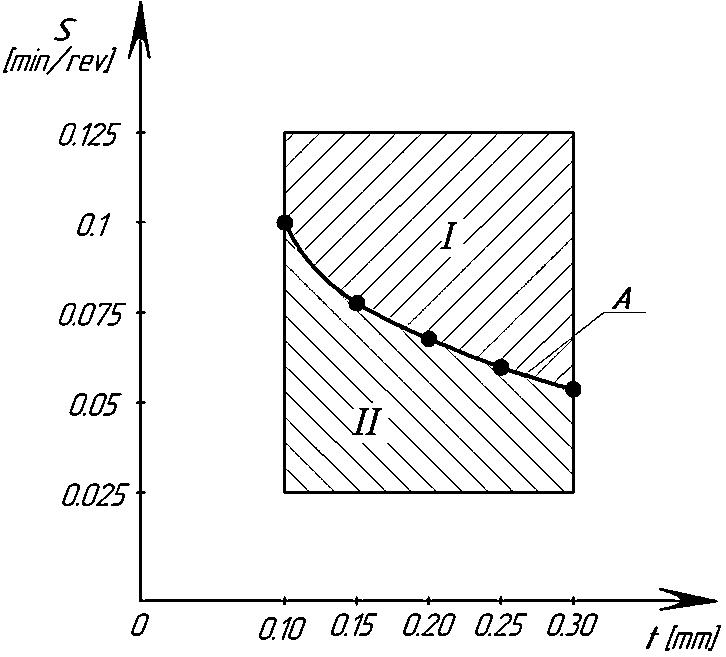
● 1 t=0.1 mm, S=0.05 mm/rev, HB=200
▲ 2 t=0.3 mm, S=0.1 mm/rev, HB=200
■ 3 t=0.1mm, S=0.1 mm/rev, HB=200
On fig. 2. shows the areas of change in feed and depth of cut, corresponding to a decrease /I/ and an increase /II/ in specific energy consumption with increasing cutting speed. When turning with modes corresponding to curve A, with an increase in cutting speed, the specific energy consumption is a constant value.
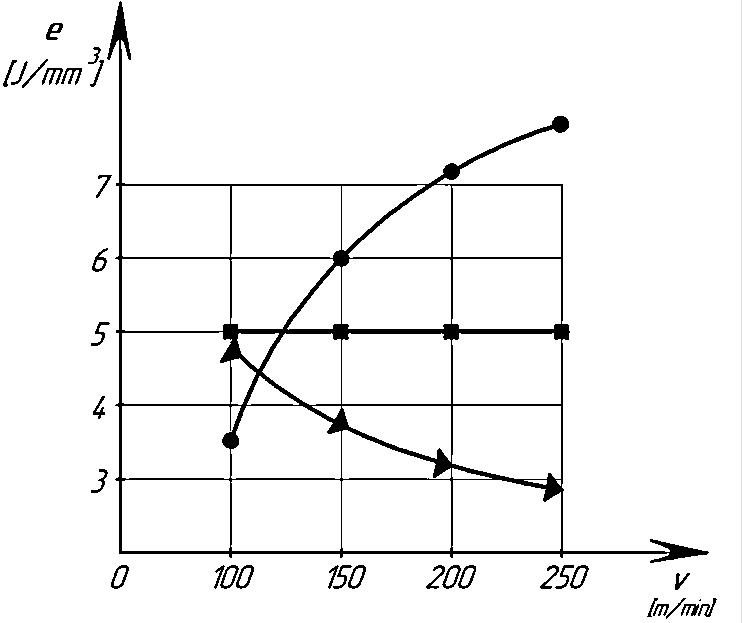
A typical effect of cutting speed on the chip formation process can be characterized by the diagram in fig. 3.
Fig.2. The areas of change in feed S and depth of cut t correspond to a decrease (I) and an increase (II) in specific energy consumption e with an increase in cutting speed V, when cutting structural steels.
Middle European Scientific Bulletin, VOLUME 24 May 2022
MIDDLE EUROPEAN SCIENTIFIC BULLETIN ISSN 2694-9970317
Fig.3. Scheme of the typical effect of cutting speed on chip settling, vertical projection of cutting force and specific energy consumption when cutting steel with a small rake angle.
According to the scheme, chip shrinkage and cutting forces, starting from a certain low cutting speed V1, decrease with increasing cutting speed. This drop continues until cutting speed V2, at which cutting forces and chip settling reach a minimum. A further increase in cutting speed leads to an increase in cutting forces and chip shrinkage, which continues up to the cutting speed V3, where the cutting forces and chip shrinkage become maximum. Finally, as the cutting speed increases above V3, the cutting forces and chip shrinkage begin to fall, and this fall, gradually fading, continues up to the highest cutting speeds.
Since chip shrinkage reflects the value of the specific work of chip formation, the nature of the change in specific energy intensity coincides with the change in the value of chip shrinkage with increasing cutting speed.
Velocity values V1, V2, V3 (Fig. 3.) depend on the thickness and width of the cut, the properties of the processed and tool materials, and the geometric parameters of the cutter.
Fig.4. Dependence of specific energy consumption on feed S and cutting speeds V. t=0.2 mm, HB=200, steel.
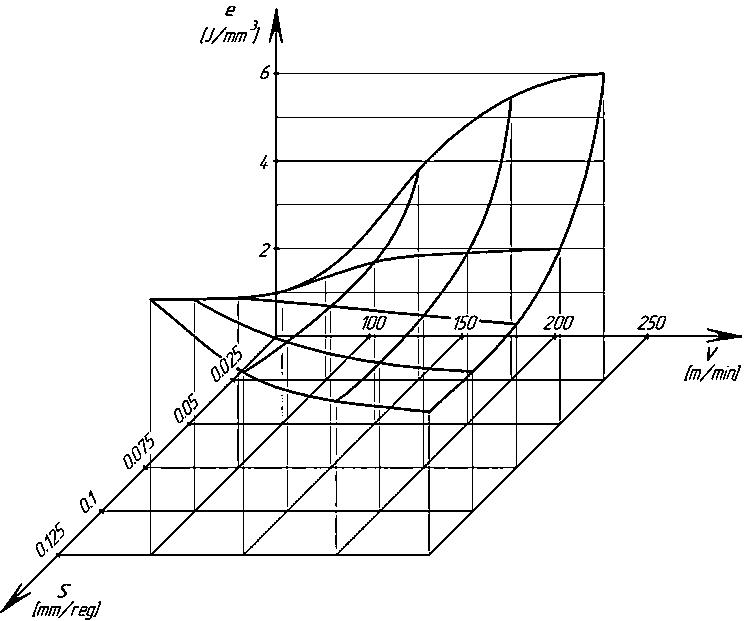
Middle European Scientific Bulletin, VOLUME 24 May 2022
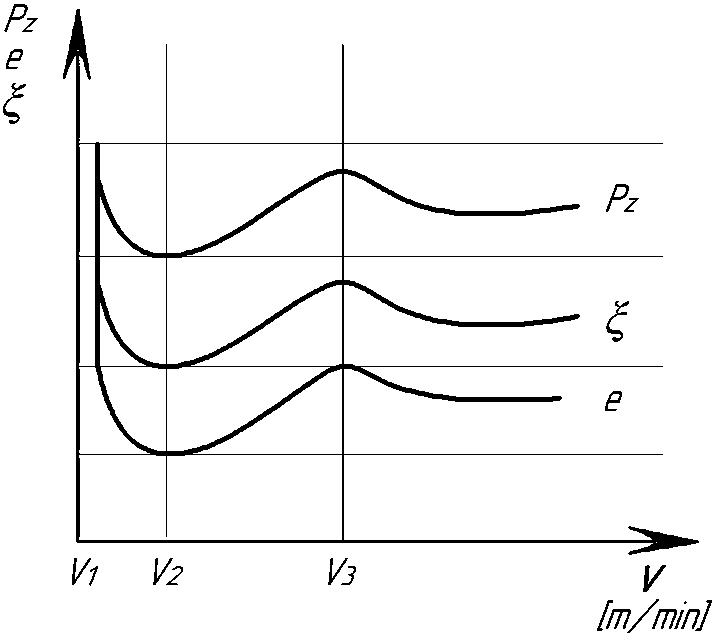
MIDDLE EUROPEAN SCIENTIFIC BULLETIN ISSN 2694-9970318
SCIENTIFIC BULLETIN
Studies have shown that the typical effect of cutting speed on the chip formation process occurs at large thicknesses of cuts, a > 0.147.
For small cut thicknesses, there is only one maximum chip shrinkage in the region of high cutting speeds. The thinner the cut, the more this maximum is shifted towards high cutting speeds. Reducing the ratio of the cut width to its thickness (less than 3÷5) also shifts the maximum chip shrinkage towards higher speeds.
When turning structural steels with cutting conditions corresponding to the II zone, the cut thickness is small and varies from 0.071 mm to 0.018 mm. The ratio of cut width to thickness varies from 1.9 to 20. In this case, the maximum chip shrinkage, i.e. the maximum specific energy intensity is shifted towards cutting speeds of more than 250 m/min. In the speed range below this value, chip shrinkage and specific energy consumption increase with increasing cutting speed, which is confirmed by experimental studies (Fig. 1).
When turning structural steels with cutting conditions corresponding to zone I, with an increase in speed from 1.7 to 4.2 m/s, the specific energy consumption decreases, which is a typical effect of speed on the chip formation process. In this case, the maximum chip shrinkage and specific energy intensity corresponds to a speed of less than 100 m/min.
Fig.5. Dependence of specific energy consumption e on feed S and depth of cut t in steel turning. V=4.2 m/s, HB=200
On fig. 4 and 5 show the change in specific energy consumption from cutting modes. An analysis of the spatial curves shows that the change in the specific energy consumption depending on the cutting conditions is complex. The value of the specific energy consumption in the finishing turning of structural steels depends very much on the cutting speed, thickness and width of the cut. The analysis of the dependences of the specific energy consumption of the cutting process on the elements of the cutting mode confirms the information content of the signal in terms of power and its suitability for use in control systems for the process of machining machine parts.
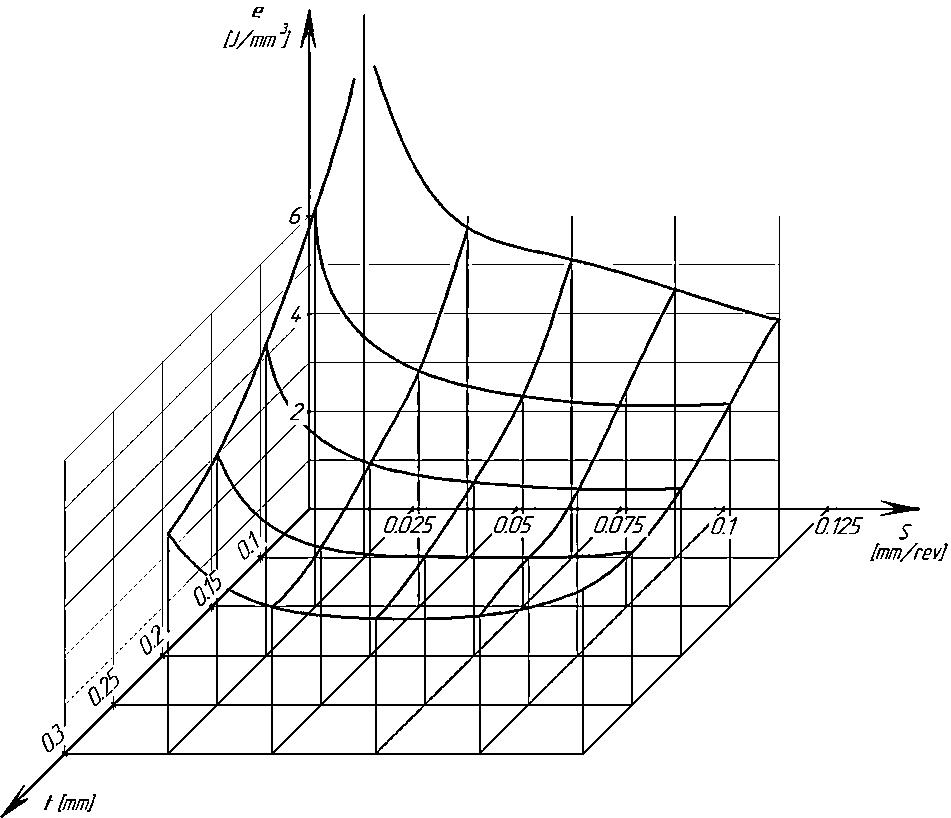
Middle European Scientific Bulletin, VOLUME 24 May 2022
MIDDLE EUROPEAN
ISSN 2694-9970319
References
1. Мамуров, Э. Т., Косимова, З. М., & Собиров, С. С. (2021). Разработка технологического процессасиспользованиемcad camпрограмм. Scientific progress, 2(1), 574 578.
2. Мамуров, Э. Т., Косимова, З. М., & Джемилов, Д. И. (2021). Повышение производительности станков с числовым программным управлением в машиностроении. Science and Education, 2(5), 454 458.
3. Мамуров, Э. Т., Косимова, З. М., & Гильванов, Р. Р. (2021). Использование программ для расчетовосновноготехнологическоговремени.
Science and Education
асосидаташхислаш. Science and Education, 2(12), 133 139.
7. Мамуров, Э. Т., & Одилжонов, Ш. О. Ў. (2021). Разработка рекомендаций по выплавке и заливки переработанного баббита в подшипники скольжения. Scientific progress, 2(6), 1617 1623.
8. Косимова, З. М., Мамуров, Э. Т., & угли Толипов, А. Н. (2021). Повышение эффективности средств измерения при помощи расчетно аналитического метода измерительнойсистемы. Science and Education, 2(5), 435-440.
9. Юлчиева, С. Б., Негматов, С. С., Негматова, К. С., Мамуров, Э. Т., Мадаминов, Б. М., & Рубидинов, Ш. Г. У. (2021). ПОВЫШЕНИЕ КОРРОЗИОННОСТОЙКОСТИ КОМПОЗИЦИОННЫХ МАТЕРИАЛОВ С ДОБАВЛЕНИЕМ ПОЛИМЕРНЫХ ДОБАВОК. Universum: техническиенауки, (10 1 (91)), 48 52.
10. Мадаминов,Б.М.,Юлчиева,С.Б.,Негматова,К.С.,Кучкаров,У.К.,Рубидинов,Ш.Г.У., Негматов, С. С., ... & Мамуров, Э. Т. (2021). АНТИКОРРОЗИОННЫЕ КОМПОЗИЦИОННЫЕ
Middle European Scientific Bulletin, VOLUME 24 May 2022
MIDDLE EUROPEAN SCIENTIFIC BULLETIN ISSN 2694-9970320
Scientific progress, 2(1), 918 923. 4. Мамуров, Э. Т., & Джемилов, Д. И. (2021). Использование вторичных баббитов в подшипниках скольжения на промышленных предприятиях. Science and Education, 2(10), 172 179. 5. Мамуров, Э. Т. (2021). Металлларга кесиб ишлов беришда контакт жараѐнларнинг виброакустиксигналгатаъсири.
, 2(12), 158 165. 6. Мамуров,Э.Т.(2021).Кесувчиасбобҳолатинивакесишжараѐнинивиброакустиксигнал
СИЛИКАТНЫЕ МАТЕРИАЛЫ ДЛЯ ЗАЩИТЫ ОБОРУДОВАНИЙ ХИМИЧЕСКОЙ ПРОМЫШЛЕННОСТИ. Universum: технические науки, (10 3 (91)), 61 66. 11. Рубидинов, Ш. Ғ. Ў. (2021). Бикрлиги паст валларга совуқ ишлов бериш усули. Scientific progress, 1(6), 413 417. 12. Qosimova, Z. M. (2021). Influence of The Design of The Rolling Roller on The Quality of The Surface Layer During Plastic Deformation on the Workpiece. 13. Рубидинов, Ш. Ғ. Ў., & Ғайратов, Ж. Ғ. Ў. (2021). Штампларни таъмирлашда замонавий технологияхромлашусулиданфойдаланиш. Scientific progress, 2(5), 469 473. 14. Рубидинов,Ш.Г.У.,&Ғайратов,Ж.Г.У.(2021).Кўпоперациялифрезалабишловбериш марказининг тана деталларига ишлов беришдаги унумдорлигини тахлили. Oriental renaissance: Innovative, educational, natural and social sciences, 1(9), 759 765. 15. Рубидинов, Ш. Ғ. У., Қосимова, З. М., Ғайратов, Ж. Ғ. У., & Акрамов, М. М. Ў. (2022). МАТЕРИАЛЫ ТРИБОТЕХНИЧЕСКОГО НАЗНАЧЕНИЯ ЭРОЗИОННЫЙ ИЗНОС. Scientific progress, 3(1), 480 486.
Middle European Scientific Bulletin, VOLUME 24 May 2022
MIDDLE EUROPEAN SCIENTIFIC BULLETIN ISSN 2694-9970321
16. Mamatov, S. A. (2022). Paint Compositions for the Upper Layers of Paint Coatings. Middle European Scientific Bulletin, 23, 137 142. 17. Рубидинов, Ш. Ғ. У., Ғайратов, Ж. Ғ. У., & Райимжонов, Қ. Р. Ў. (2021). ИЗНОСОСТОЙКИЕМЕТАЛЛОПОДОБНЫЕСОЕДИНЕНИЯ. Scientific progress, 2(8), 441 448. 18. Тешабоев, А. Э., Рубидинов, Ш. Ғ. Ў., Назаров, А. Ғ. Ў., & Ғайратов, Ж. Ғ. Ў. (2021). Машинасозликдаюзатозалигининазоратиниавтоматлаш. Scientific progress, 1(5). 19. Рубидинов, Ш. Ғ. У., & Раимжонов, Қ. Р. Ў. (2022). ИЗМЕНЕНИЕ МИКРОРЕЛЬЕФА ПОВЕРХНОСТИ И ШЕРОХОВАТОСТИ ДОПУСКОВ ДЕТАЛЕЙ ПОСЛЕ ХИМИЧКЕ ТЕРМИЧЕСКИЙОБРАБОТКИБОРИРОВАНИЯ. Scientific progress, 3(1), 34 40. 20. Mamirov, A. R., Rubidinov, S. G., & Gayratov, J. G. (2022). Influence and Effectiveness of Lubricants on Friction on the Surface of Materials. CENTRAL ASIAN JOURNAL OF THEORETICAL & APPLIED SCIENCES, 3(4), 83 89. 21. Рубидинов, Ш. Ғ. У., Ғайратов, Ж. Ғ. У., & Ахмедов, У. А. У. (2022). МАТЕРИАЛЫ, СПОСОБНЫЕ УМЕНЬШИТЬ КОЭФФИЦИЕНТ ТРЕНИЯ ДРУГИХ МАТЕРИАЛОВ. Scientific progress, 3(2), 1043 1048.





